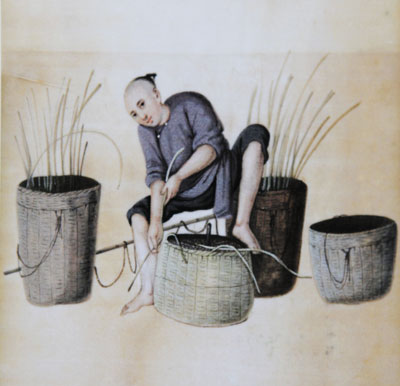
Cao Zhen caozhen0806@126.com MORE than 100 watercolor and gouache paintings on pith paper created in Canton exclusively for export to Europe and America in the 19th century are on display at the Shenzhen Museum’s Civic Center outlet, presenting a panorama of life in China during the Qing Dynasty (1644-1911). Pith paper is made from a kind of tetrapanax plant in southern China. The paper is semitransparent and the colorful drawings on it look like exquisite embroidery, producing a bright and even sparkling effect. According to Wang Xiaochun, an ancient art researcher at the Shenzhen Museum, because of the transparent nature of pith paper, paintings on it could easily be mass-produced by artisans for wholesale. Since pith paper is very fragile, the paintings are about the size of a postcard and were mainly purchased as souvenirs in the 19th century. “At that time, many Western visitors to China were eager to take what they had seen here back to their countries and they found the pith paper paintings very appropriate as souvenirs before the invention of photography,” said Wang. The paintings depicted images of Chinese culture, showing figures ranging from street beggars to likenesses of the imperial family, landscapes, harbor views, the process of making tea, ritual ceremonies, animals and prison torture. These paintings were highly valued by Westerners as charming scenes of exotic life. According to Wang, pith presumably came into use for paintings to satisfy the increasing demand for small, inexpensive and easily transportable souvenirs following the massive explosion of Chinese exports from Canton (today’s Guangdong) in the early 19th century. Paintings on pith were produced by artisans rather than by masters, pretty much like those in today’s Dafen Oil Painting Village in Shenzhen, and they were therefore not accepted as art. “From a historical perspective, we still appreciate the artistic value of pith paper paintings,” said Wang. Wang said there were about 3,000 artisans in 30 painting studios in Canton run by professional painters who studied Western art from Western painters like George Chinnery, so Western influences can be seen in some of the paintings. By 1846, photography had arrived, so pith paper paintings lost their exotic attraction and Japanese art and designs were outselling Chinoiserie. The exhibits were provided by Shenzhen Jinyu Company, who bought the paintings from overseas markets. Most paintings on pith paper created in the 19th centuries are now housed in museums overseas or in the hands of foreign private collectors. Wang said the making of pith paper and this unique historical painting style had been lost for several decades. In 2000, a Briton named Ivan Williams donated over 70 pieces of pith paper watercolors to the Guangzhou Museum. Experts are now trying to preserve this craft as an intangible cultural heritage. Dates: Until Nov. 1 Hours: 10 a.m.-6 p.m. Closed Mondays Venue: Shenzhen Museum, Block A, Civic Center, Futian District (福田区市民中心A区深圳博物馆新馆) Metro: Shekou or Longhua Line, Civic Center Station (市民中心站), Exit B | 
